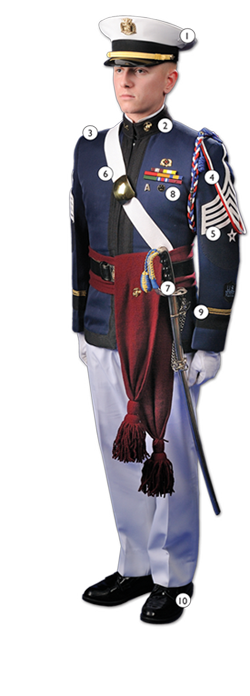HOW TECH TICKS
The lint rollers resting on a windowsill inside the main entrance to Brodie Hall testify to a truism anyone who's spent time on the Virginia Tech campus can tell you: Cadets must pay an impressive amount of attention to their attire.
The training begins early. Each July, new cadets file into the university's tailor shop for fittings. Led by manager Dean Miller, the shop's staff of six prepares uniforms. The "Dress A" uniform (worn by Daniel Tolbert below) is one of the most recognizable.
Let's take a look at the significance of selected elements—and the exacting standards in which they're displayed.

The cover is worn with the visor two finger-widths from the nose. Upperclassmen have the privilege of wearing the wind strap down, which helps keep the cover in place. Gold bands identify officers and silver bands identify fifth-year cadets. Many cadets line the inside of their covers with photos. "The pictures that I keep in my cover are of me and my little brother and sister. I am the oldest of seven children, and they are the youngest. … Having them in my cover is a constant reminder of my love for them," said cadet Jacqueline Jackson.
Commonly referred to as a headlight, a brass VPI insignia is placed on the left side of the collar; seniors wear their branch of service insignia instead. On the right side of the collar, among other variations, Civilian-Leader Track cadets wear a crossed cannon disk or a sword pin, and underclassmen wear a ROTC headlight.
While seated, cadets may unzip the blouse up to two inches. "It can get pretty warm wearing the blouse because it's wool-lined, but you can't take it off. You can unzip it to a certain point, but your undershirt can't be seen," said cadet Daniel Syed Jr.
Cords are worn on the left shoulder of the blue blouse and signify membership in a particular organization or unit. Every company vies to earn one of the corps' most-coveted privileges, the Beverly S. Parrish Jr. Memorial Award and its accompanying gold citation cord, which indicates the unit that accumulates the greatest number of competitive points for the academic year.
Indicative of rank, chevrons are cut by hand at the tailor shop, where at least 750 pairs are made each year, Miller said.
Underclassmen in "Dress A" wear both crossbelts, while seniors wear only one crossbelt and a maroon officer-of-the-guard wrap.
Officers may carry a saber. "The corps provides sabers to seniors who want to have them. … I decided to use my own saber, which is like a family heirloom. It dates back to the Civil War and is one of my most prized possessions," said cadet Daniel Tolbert.
Ribbons, pins, and medals are added in recognition of accomplishments, membership, and special distinctions.
Gold stripes near the cuffs of the blouse sleeves signify the number of years a cadet has been in the corps and indicate a cadet's privileges, duties, and position eligibility. The glove, meanwhile, may be cut to reveal a class ring.
Black, plain-toed, low-quartered shoes must always be immaculate. "Typically, we probably spend 15 minutes twice a week polishing shoes. Once you've been polishing them for a while, it doesn't take as long," Tolbert said.